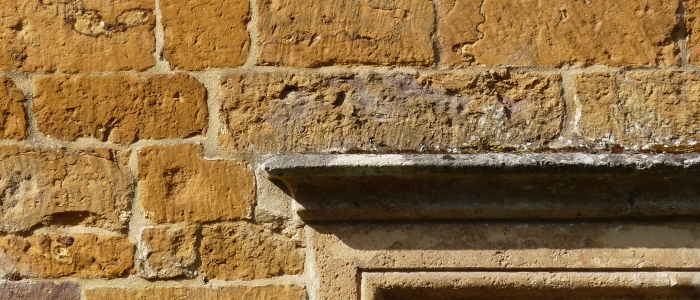
Materials
 By Matthew Slocombe
Published 29 October, 2012
By Matthew Slocombe
Published 29 October, 2012
Matthew Slocombe is Director of the Society for the Protection of Ancient Buildings (SPAB) and author of the Shire book ‘Traditional Building Materials’.
Understanding materials and the way they were used is crucial to the care and conservation of historic buildings.
Materials are at the heart of a building’s story
Traditional materials were often produced or extracted close to a building site, giving a strong sense of local identity. This is often known as ‘vernacular’ building. Specialist craft techniques evolved to make use of these materials. Sometimes though, where there was a different impetus such as fashion or the display of status, local resources could be consciously rejected. A house in London fronted in imported stone, or a Modernist pavilion built of concrete represented a wish (and the financial resources) to be different. In all cases, materials and the way they have been used, are at the heart of a building's story.
The importance of breathing
Materials used in historic buildings often have a relative softness that contrasts with those in modern construction. 'Soft' traditional materials, like cob and other forms of earth walling, “rubbing” bricks used for arches and quoins, or clunch (a chalk-like stone), perform perfectly well over long periods, provided they are protected from excessive moisture through good maintenance and are allowed to “breathe”. “Breathing”, in historic building terms, means allowing moisture to evaporate from or through a wall. Modern paints and cement-based materials can harm old buildings by trapping moisture, preventing the natural evaporation process.
Old materials can be flexible
Until the early 20th century, most mortars, plaster and renders in the UK were a mix of lime, aggregate (sand/gravel) and sometimes animal hair. Lime, produced by burning limestone in a kiln, is a a key component of much traditional building in the UK, and lime-based materials will generally be required for repair and maintenance work. Lime comes in a variety of types and choosing the one most suitable and using it correctly may require specialist skills or training. Lime or earth-based construction also brings relative structural flexibility to historic buildings, compatible with shallow foundations and allowing a degree of seasonal movement.
In traditional timber-framed construction, seasonal movement is also to be expected: splits in timbers or leans in walls often occurred early in a building's life and are not necessarily a cause for concern unless monitoring shows them to be getting worse.
Repair and clean with care
Many building materials have a long history of use in the UK. Stone, brick, earth, timber, thatch and glass have all been used for centuries. Even corrugated iron and mass concrete can now claim to be traditional. But the manner in which materials' have been produced and employed has changed considerably over time. People working with traditional materials therefore need understanding and experience of them as well as sympathy for the historic structures they form. It is very easy to cause damage quickly through inexperienced workmanship. Effective repair not only requires the right skills but also a supply of compatible materials. This might be the type of thatch traditional to an area, handmade bricks and tiles, or local stone.
A supply of suitable new materials is important to the long term care of old buildings. Secondhand materials sometimes offer an alternative source, but think carefully about their origin (the theft of traditional materials is a continuing problem) and about their remaining lifespan.
Traditional materials often mature with age, giving a building its historic character. Cleaning should therefore be approached with caution as, if not very carefully undertaken, it can cause damage and remove attractive patination. Looked after properly, structures built from traditional materials offer a practical and pleasing alternative to modern buildings and will survive to benefit many future generations
Where to find out more
General advice on traditional materials and suggestions of contractors
-
Society for the Protection of Ancient Buildings (SPAB)
Technical advice line 0207 456 0916 Mon-Thurs 9.30-12.30
www.spab.org.uk -
Historic England
https://historicengland.org.uk/research/current-research/conservation-research/sourcing-traditional-materials/
Brick and tile
-
British Brick Society
www.britishbricksoc.free-online.co.uk -
Tiles and Architectural Ceramics Society
www.tilesoc.org.uk
Stone and lime
-
British Geological survey
www.bgs.ac.uk -
Building Limes Forum
www.buildinglimesforum.org.uk -
National Slate Museum, Wales
www.museumwales.ac.uk -
Stone Roofing Association
www.stoneroof.org.uk
Metals
-
Coalbrookdale Museum of Iron
www.ironbridge.org.uk/our_attractions/coalbrookdale_museum_of_iron -
Lead Sheet Association
www.leadsheetassociation.org.uk -
National Heritage Ironwork Group
www.nhig.org.uk
Earth
-
Devon Earth Buildings Group (DEBA)
www.devonearthbuilding.com -
East Anglian Earth Buildings Group (EARTHA)
www.eartha.org.uk
Timber and thatch
-
Weald and Downland Open Air Museum, Sussex
www.wealddown.co.uk -
SPAB Thatched Roofs
www.spab.org.uk/advice/technical-qas/technical-qa-29-thatched-roofs/ -
Forestry Stewardship Council UK
www.fsc-uk.org
Glass
-
Maintaining traditional plain glass and glazing
www.historic-scotland.gov.uk/informguide-historicglass.pdf -
Stained glass and historic glazing
www.churchcare.co.uk/churches/conservation/caring-for-conservation-of-artworks-historic-furnishings/stained-glass-historic-glazing
Paint
-
Traditional Paint Forum
www.traditionalpaintforum.org.uk
Tools
-
Museum of English Rural Life, Reading
www.reading.ac.uk/merl -
Tools and Trades History Society
www.taths.org.uk